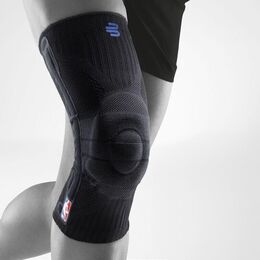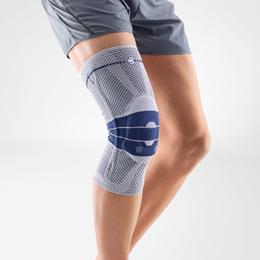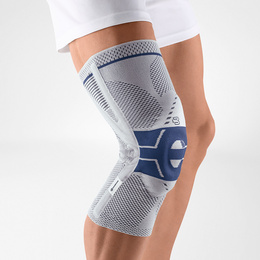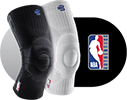Explore our knee braces, supports and straps for performance and recovery.
Knee pain can occur in all kinds of situations – for example when you get out of bed in the morning, get out of the car after a long drive, or even while you’re taking a short walk. What’s more, those who experience knee pain aren’t always aware of what’s causing it.
Seemingly unexplainable knee pain is often caused by excessive or inappropriate mechanical stress brought about by athletic or professional activity, or even simply age. However, normal everyday movements can also lead to excessive mechanical stress. Sometimes people don’t realize that their knee pain has been caused by a fall or incorrect movement because they don’t notice the pain until sometime after such an event has occurred.
When pain only gradually becomes noticeable, and its causes are unclear, many of those affected wonder what they should do and whether they should see a doctor. In many cases, pain can be eliminated by taking measures to protect the knee for a while. Depending on the actual cause of knee pain, certain types of treatment may nevertheless become necessary. Such treatment options include pain medication, physical therapy, and surgery. At the same time, wearing a Bauerfeind knee brace or support can help reduce knee pain and stabilize the joint.
Typical knee pain
Constant pain that worsens when weight is placed on the knee could be caused by wear in the knee joint. Other possible causes include inflammation or ongoing excessive strain. Older individuals often have constant knee pain that makes standing and walking a torturous experience. Anyone who experiences such constant knee pain should make sure to consult a physician.
It’s important to be aware of the fact that knee pain is a signal to warn you that you need to protect your knee joint against further stress. In the case of wear, however staying completely immobile can actually increase the level of pain, and is therefore not a suitable solution. On the other hand, remaining immobile for only an hour or so after placing excessive strain on the knees, or participating in an athletic or other activity that is gentle on the knees, can help alleviate pain. Here, use of a knee brace or support can stabilize the knee joint and reduce the mechanical stress.

Causes of knee pain

The causes of knee pain are extremely varied.
Knee pain can be caused by, among other things:
- Injuries resulting from athletic activity or accidents (bruising)
- Inappropriate mechanical stress and excessive strain
- Osteoarthritis
- Inflammation (arthritis)
- Inflammation of a bursa
- Autoimmune diseases
- Metabolic disorders
Play it safe: Consult a physician if you experience unusually intense and persistent knee pain.
Osteoarthritis (OA) - Wear in the knee joint as a cause of knee pain
Osteoarthritis is a condition in which cartilage in a joint breaks down slowly. In the knee joint, this cartilage functions as a protective layer between the thigh and lower leg bones. If left untreated, osteoarthritis can cause cartilage in the knee joint to deteriorate to such an extent that the two bones begin to rub directly against each other.
Knee pain caused by wear typically occurs after a person begins moving again following a long period of inactivity – i.e. after sitting or lying. Physicians use the term “pain on movement” if pain dissipates after the first few steps are taken.
As the arthritis progresses, the level of pain usually increases and pain can even occur during periods of inactivity. It should be noted, however, that the progression of osteoarthritis, and the level of pain experienced, varies among those afflicted with the disease. This means that the extent to which the illness has progressed unfortunately cannot be determined by either the duration of pain or its intensity. In addition, many of those who suffer from osteoarthritis experience pain only intermittently.
When a patient suffers from arthritis, finding a knee brace that offers support and effective pain relief while also being comfortable to put on can be a challenge. According to extensive testing by independent researchers, the Bauerfeind GenuTrain® knee brace is proven to relieve OA pain and improve knee stability while its anatomical shape and donning aids make it easy and comfortable to wear.
The Arthritis Foundation has awarded GenuTrain its coveted “Ease of Use” commendation, a certification recognizing products proven to make life easier for people who have arthritis and other physical limitations. Independently tested by experts and evaluated by people with arthritis, “Ease of Use” products are easy to use by everyone.
Meniscopathy - Meniscal damage as a cause of knee pain
The meniscus is a two-part cartilage (each part is crescent-shaped) in the knee joint. Each knee has two menisci (medial and lateral meniscus) that either absorb or cushion tensile forces. Meniscopathy is the term used to describe meniscal damage not caused by trauma. In other words, meniscopathy refers to damage primarily caused by wear due to inappropriate mechanical stress and excessive strain over a long period of time. However, injuries such as cruciate ligament tears (post-traumatic) can also lead to meniscal damage. In addition, meniscal tears can be caused by abrupt rotational movements that occur at work or when participating in sports. Depending on whether the medial or lateral meniscus is affected, the result will be stabbing pain on either the inner or outer side of the knee joint.
Diagnosing knee pain
Because knee pain can have so many different causes, a consultation with a physician or other healthcare provider must be carried out before a diagnosis can be made. The provider will ask the patient to explain when their symptoms began, how long the knee pain lasts, and what it feels like. Patients will also be asked to describe any accompanying symptoms or pre-existing conditions they may have.
Next, the physician will examine the patient to determine the extent of knee joint mobility. Various movement tests can provide indications of specific injuries that may be present. In order to ensure a reliable diagnosis, these tests are usually followed by imaging procedures such as ultrasound, X-ray, MRI, or arthroscopy (minimally invasive examination of the knee joint).
Treating knee pain
The most important component of treatment is to immediately alleviate pain by avoiding excessive strain. Subsequent treatment is designed in line with specific causes. In many cases a knee brace or support will be used to stabilize the knee joint, protect injured knees, and relieve pain.
According to athletic trainers, physical therapists, and other healthcare professionals, one of the first measures taken in the case of most injuries involves a tried and tested method: RICE Therapy (Rest, Ice, Compression, Elevation).
Healing support for knee joints
Medical knee braces and supports from Bauerfeind can offer effective assistance when treating knee pain. The anatomically shaped GenuTrain® knee brace relieves and stabilizes the knee joint. This support is made of a knitted fabric with an integrated ring-shaped Omega pad (functional cushion) that provides optimal relief to the joint by diverting pressure away from the kneecap to other soft tissue structures in the knee.
Two nubs on the lower edge of the pad – the Hoffa pads – exert metered and targeted pressure on the infrapatellar fat pad (Hoffa's fat pad) in the knee joint, providing further relief to the kneecap. In addition, integrated lateral wings on the product help relieve meniscus pain in a targeted manner.
When a person moves, the knee support acts like an intermittent compression massage unit by alternately increasing and decreasing pressure. This stimulates blood flow and promotes the healing process.
The GenuTrain® knee brace is made of a breathable knitted fabric and is comfortable to wear. It adjusts to every movement, does not constrict, and will not slip out of place. The support is also particularly soft and elastic in the sensitive area behind the knee. GenuTrain combines optimal effectiveness with a high level of wearing comfort.
Learn more about Bauerfeind knee braces for knee pain:
The most common causes of knee pain include:
Bone fractures, most commonly the patella (kneecap)
- Sprains
- Dislocations
- Tendonitis, also known as “Jumper’s Knee”
- ACL (anterior cruciate ligament) tears
- Meniscal tears
- IT Band syndrome
- Knee Arthritis / Knee Osteoarthritis (OA)
Many healthcare professional agree that the first course of action in treating acute knee pain is RICE Therapy. RICE stands for rest, ice, compression and elevation. After a knee sprain it is best to rest the joint, put it on ice, apply compression with a medical-grade compression knee brace or support, and prop it up.
Wearing a medical-grade compression brace from Bauerfeind as part of your treatment of knee pain can provide the stability and pain relief you need to recovery more quickly. Learn more about Bauerfeind’s knee pain solutions on our Knee Braces page.
Other treatment options for knee pain include:
- Over-the-counter drugs like Acetaminophen (name brand Tylenol) and non-steroidal anti-inflammatory drugs (NSAIDS) like Aspirin, Ibuprofen and Naproxen.
- Knee-strengthening exercises overseen by your doctor or physical therapist
- Knee injection therapies
- Surgery to remove, repair or replace an injured ligament, tendon, meniscus or patella
As always, it’s best to seek the care of a healthcare professional to determine the best treatment for your knee pain.
We suggest that you seek advice from your doctor to ensure you get the correct brace for your specific condition. Of course, we are always available to assist in selecting the right brace, but our advice does not take the place of talking to your doctor. Contact us via phone, email or live chat.










